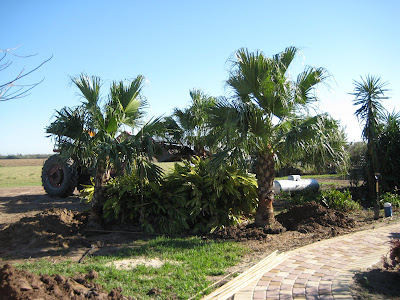 Garden designers often mention the "bones" of the garden. A garden's bones are both permanent and structural - walkways, pergolas, raised beds, fountains, statuary - Today we added some of my favorite garden bones back to our garden: trees (well, trees of a palm variety). A few months ago, a huge, old Ashe tree, Fraxinus velutina, stood here - Hurricane Dolly tore it past the point of recovery. I love the addition of these three Chinese Fan Palms, Livistonia chinesis. They add height, a focal point, and some much needed shade to the area.
Garden designers often mention the "bones" of the garden. A garden's bones are both permanent and structural - walkways, pergolas, raised beds, fountains, statuary - Today we added some of my favorite garden bones back to our garden: trees (well, trees of a palm variety). A few months ago, a huge, old Ashe tree, Fraxinus velutina, stood here - Hurricane Dolly tore it past the point of recovery. I love the addition of these three Chinese Fan Palms, Livistonia chinesis. They add height, a focal point, and some much needed shade to the area.
The picture at the left was taken last April when we removed the Chinese Fans for a remodeling project. Like most palms, a small rootball was all that was needed. Because we were going to hang onto them for an extended period, we placed them in large pots. Don't you love how I use the term "we"? It's not like I'm in the picture doing any of the work. I do love most aspects of gardening BUT there are some projects that are best left to professionals - those who have both the knowledge and equipment to get the job done.

Nine months in pots didn't seem to harm these large palms at all. To help insure their health, we did place them on an automatic watering system.

Nine months in pots didn't seem to harm these large palms at all. To help insure their health, we did place them on an automatic watering system.
Chinese Fan Palms are a slow growing, relatively short fan palm with very large leaves. The average mature height is listed as 25' - this makes it a nice size for single story homes. Chinese Fans are cold hardy, withstanding several degrees below freezing with no damage. They tolerate poor soils (these three have heavy Harlingen clay in their new home) but respond well to a fertility program. Give this palm plenty of room as it's canopy will measure about 12-14 feet wide.
4 comments:
The relatively small size of the rootball on those palms would surprise me if we hadn't seen them here, Mary Beth...that grouping does look good and I love that editorial 'we'.
Your Chinese Fan Palms are lovely but they're zone 9. We have only one palm so far - went with the hardier Mediterranean Fan Palm/Chamaerops humilis and also want a palmetto.
It really is different to live where the bones can be broadleaved evergreens and palms - Happy 2009!
Annie at the Transplantable Rose
It is amazing that even
50' tall palms have very little root systems. I can't figure out how they stand since they have no tap root or long lateral roots. When did you plant them? Most all palms go in the ground here in July/August. They are about the only plant that can make it planted at height of summer!
Your three look great in their new location.
Aiyana
Mary Beth,
As long as you are directing you are part of the "we". HA
Your palms are going to be perfect in that spot... so tall and beautiful.
The only thing I don't like about palms is having to trim the ugly fronds they shed. Can you believe I don't have a single palm in my garden? I did remove one when we moved in. I LOVE seeing them elsewhere though.
ANNIE - Since a palm is more of a grass than a tree, it regenerates its roots very effectively. Each variety requires a different size rootball. I, too, am looking to add a palmetto (Texas Sabal) somewhere in my garden!
AIYANA - I wonder how they remain upright, too! Maybe having a relatively small canopy helps. I did notice that shade trees sustained much more damage in our hurricane last summer than did palm trees. You are so right that palms SHOULD go in the ground when it's warm and their roots will take hold - BUT we chose to plant ours last week - it just happened to be when we had men available to do the work.
MEEMS - My husband has always complained about the "messiness" of palms. But I tend to think that they don't take any more care than large shade trees. And I just love the look. . .
Post a Comment